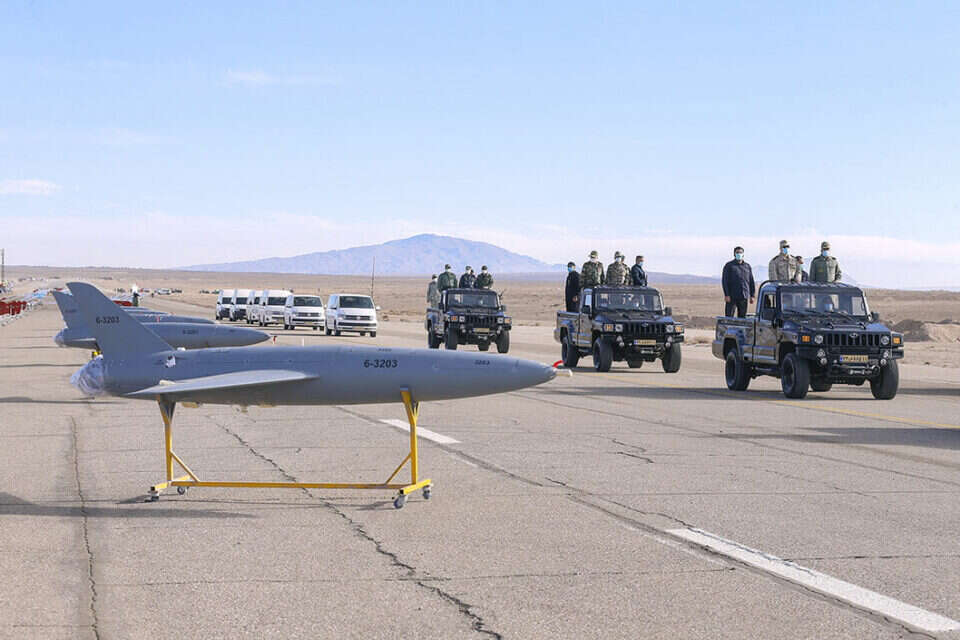The threat of Iran's unmanned aerial vehicles has been perceived, until recently, as an important but not necessarily crucial component in Tehran's power building; But in recent months, perceptions have changed in a way that is reflected not only in intelligence materials, but also in speeches by senior Israeli officials, including Prime Minister Naftali Bennett and Defense Minister Bnei Gantz.
Last September, Bennett devoted part of his speech to the UN General Assembly, telling the world that only this year has Iran begun operating a new lethal terrorist unit - swarms of deadly UAVs, armed with weapons that can attack anywhere and anytime.
Bennett added that Iran had already carried out attacks using unmanned aerial vehicles in the Middle East, noting that the Iranians "plan to cover the country's skies with this deadly force."
Ganz, for his part, recently revealed that Iran was trying to transfer explosives from Syria to terrorist elements in Judea and Samaria - using an unmanned aircraft.
The fact that the Iranians are developing UAVs, operating them and supplying them to their envoys in the Middle East is not new. Country.
Bennett on the struggle against Iran: "Hopefully the world will not blink, there may be disagreements even with the best of our members" // From the YouTube channel of the Institute for Policy and Strategy
But it seems that the key moment, which put Iran's unmanned aerial vehicles on the map, occurred in September 2019: the Iranians then used UAVs and cruise missiles launched about 1,000 kilometers to attack Saudi oil sites. They caused extensive damage to the Aramco facility. , In a way that disrupted the kingdom's oil production capability for many months.
Several more incidents of Iranian use of unmanned aircraft have since been reported;
Central to this is the attack on the ship Mercer Street, which sailed from the port of Dar es Salaam in Tanzania to a port in the United Arab Emirates.
The ship was attacked at least twice, resulting in the killing of the ship's British captain and a Romanian citizen who was on the security crew.
Although less than two UAVs were involved in the attack on Mercer Street than in the attack on Saudi oil facilities, the operation was no less operationally and technically impressive - and testified to Iran's long-term attack capabilities.
It was recently reported that the Islamic Republic used UAVs in other cases, and among other things it was reported that UAVs were also used to attack the American base in al-Tanaf in eastern Syria.
No casualties were reported in the attack after Israel - according to foreign publications - warned the United States in advance about the attack.
March in Tehran, archive, Photo: Reuters
Abilities that have not yet been revealed
Iran has several types of unmanned aircraft. Some are large and have a range of thousands of miles for observation and attack; Others are "suicidal" UAVs, smaller and simpler. The problem is exacerbated by the fact that Iran not only operates the same aircraft itself, but also equips them with missiles throughout the Middle East, such as Yemen, Iraq and Syria. Due to their being very efficient, simple to operate and manufacture and not particularly expensive. Operationally they are accurate, very difficult to detect due to their low radar signature and not easy to intercept; Strategically, the fact that Iran can launch non-surface aircraft allows it to obscure its involvement in operations, and consequently not elicit a significant military response. The great disadvantage of UAVs lies in the fact that their carrying capacity is small compared to missiles and rockets.
Speaking at Reichman University recently, Gantz revealed that Iran is "developing additional capabilities through the UAVs, which have not yet been exposed." Another UAV interception that took place over the Springs Valley on May 18, during Operation Wall Guard. To Aviv Kochavi in their speeches after the operation.
President Biden and Prime Minister Bennett at their meeting in Washington, Photo: AFP
The United States is also troubled
The issue of Iranian UAVs is also very troubling to the United States. Although the Biden administration rarely imposes sanctions on Iran, last October the US Treasury Department imposed sanctions on companies and individuals connected to Tehran's UAV system - following intelligence information provided by Israel. In radars deployed in the Middle East and can provide Israel with early warning of the launch of UAVs into its territory.
One way or another, Iran's unmanned aerial vehicles should not be seen as a secondary weapon of importance.
It should be regarded as one that could be equivalent to Tehran's precision-guided rockets and missiles, and a means that could constitute a 'tie-breaker', or at least one that could produce a victory picture for the Iranians.
The speeches of the senior officials indicate that the Israeli defense establishment understands this.
Currently, the Israeli response to UAVs includes, among other things, their interception by "soft" means such as electronic warfare, by kinetic means such as fighter jets - and also by an Iron Dome system, which has been adapted in recent months and even intercepted several UAVs launched from Gaza.
Were we wrong?
Fixed!
If you found an error in the article, we'll be happy for you to share it with us

